It’s been over a decade since we first began germinating peony seeds from open and controlled crosses. This has been with varying degrees of success and one learns with time of course. We shall not discuss all the details of hybridizing and germinating peony seeds, there’s already an excellent article on the site here from Nate Bremer. What we have done this year is a little experiment to find out which substrate is best to germinate peony seeds. To take a slide from the article just mentioned, this shows some substrates often used to germinate peony seeds:
In the past we have germinated peony seeds in outside garden soil, potting soil, coarse river sand, compost and perlite. We actually only use indoor germination as outside germination is slower and, at least we find, is quite erratic. Compost and potting soil gave different results one year to the next and was quite a gamble. We don’t seem to have a green thumb as so many other people have… Last year we used perlite and it turned out this was far better than potting soil and also much easier to work with. However some germinated seeds showed some damage on the roots that appeared and a few of those even rotted. It’s however very easy to give a certain amount of water when you start from fresh dry perlite. So we intended to try different treatments this year and see if we would get different results. Someone in the hybridizer’s corner with a whole lot more mileage in hybridizing suggested me trying vermiculite as that is his preferred substrate. I’m not someone to take good advice lightly and thus I’ve bought a large bag of vermiculite to incorporate it into my experiment.
So, how did we go about it? At the middle of August we harvested some open pollinated seeds from an easy seeding cultivar, in this case Just Peachy. From previous experience we knew it germinates quite well. We threw away the cracked already ‘open’ seeds which are shown in the next image so as to have only perfectly round seeds. The ‘floaters’ were also thrown away as all others that seemed to be somewhat ‘different’. This to have somewhat comparable seeds for the different treatments. Seeds were then randomly allocated to the following:
Three different completely dry substrates with different amounts of water added. Coarse river sand (10 and 25% water (volume/volume)), perlite (0-5-10-15-20-25%) and vermiculite (0-5-10-15-20-25-30-35-40-50%). In practice we simply took a water measuring cup, filled it to the right volume and then added the amount of water needed. For example 1 litre of vermiculite received 0,25 litre of water to have a 25% water content. The vermiculite absorbed all the water, so the total volume remained at 1 litre in this case. This was also the case with all other treatments, only with vermiculite at 50 % water, could we see that this was above the saturation maximum and some water remained floating in the ziplock bag. Each different treatment had 20 seeds of Just Peachy which seemed like a good number to work with.
Now this was all done mid-August. The ziplock bags with the substrate and seeds were placed in our greenhouse and then all we had to do was wait. It has been an exceptionally warm Autumn and many of our other seeds already germinated by the beginning of November. Thus we have opened our ziplock bags with the Just Peachy seeds as well, searched for the seeds and sorted them in one of five categories: large roots (5 cm +), average roots (2-5 cm), short or beginning roots (0,1-2 cm), no roots but still good seeds, and finally rotted seeds.
Let’s have a look at the results:
| % water | Long roots | Average roots | Short roots | No roots, good seeds | Rotted seeds |
| Coarse river sand | |||||
| 10% | 20 | ||||
| 25% | 20 | ||||
| Perlite | |||||
| 0% | 20 | ||||
| 5% | 2 | 1 | 2 | 15 | |
| 10% | 3 | 1 | 16 | ||
| 15% | 5 | 1 | 14 | ||
| 20% | 1 | 6 | 4 | 9 | |
| 25% | 8 | 12 | |||
| Vermiculite | |||||
| 0% | 20 | ||||
| 5% | 9 | 1 | 8 | 2 | |
| 10% | 9 | 2 | 3 | 2 | 4 |
| 15% | 5 | 2 | 3 | 10 | |
| 20% | 7 | 1 | 2 | 10 | |
| 25% | 6 | 1 | 1 | 12 | |
| 30% | 7 | 6 | 1 | 6 | |
| 35% | 1 | 1 | 2 | 8 | 8 |
| 40% | 3 | 6 | 11 | ||
| 50% | 20 | ||||
| Total always 20 seeds per treatment. Numbers with orange background had some rot at the end of the roots. Green background shows the best treatment. Seeds harvested August 11th. Treatments started August 12th. Opening of ziplock bags November 10th. | |||||
Some insights can be had from the numbers in the table. Keeping them dry (0% water in perlite or vermiculite) results in nothing, as would be expected. But, unexpectedly, if the substrate is too wet, this also results in nothing. The 50% water in vermiculite did not result in all rotted seeds, but they came out perfectly sound. Coarse river sand is immediately too wet it seems, even at 10% none of the seeds made any movement towards germination.
From the three substrates, vermiculite is clearly the best, followed by perlite and then, with no germinations, coarse river sand. Some treatments resulted in germination and roots but the substrate was too wet for them to remain healthy and some rot showed up at the root tip growing points usually (those have been marked by an orange background). Many of the rotted seeds also showed the beginnings of germination but the roots had rotted soon after breaking through the seed coat. Apparently the most rot occurs when the roots start growing and it’s less the seeds themselves that start to rot.
The best treatment needs a lot less water than what we oursevels expected initially. My standard treatment for all other seeds this year was 25% water in vermiculite. As can be seen, this is too much humidity for them. The most germinated seeds with the longest roots can be had from vermiculite with only 10 % water added (shown in a green background). As we all know, some seeds are simply inclined to rot, no matter what treatment you give them. But in this case we have 14 germinated seedlings, 2 that might still germinate later on and 4 that had rotted. This is 70% germination and is the best in the table.
Seeds from other crosses and harvested at other times will give different results of course, but the general message is clear: use vermiculite with only 10% water in ziplock bags for the best germination of your peony seeds!
As always, all errors are only to blame on ourselves and your own experiences or questions are most welcome in the comments section below. To conclude a few images from some of the different treatments.

Just Peachy seeds with long roots
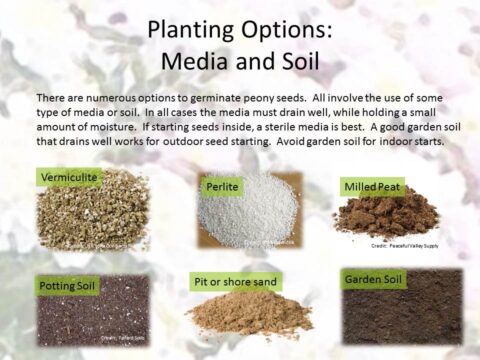



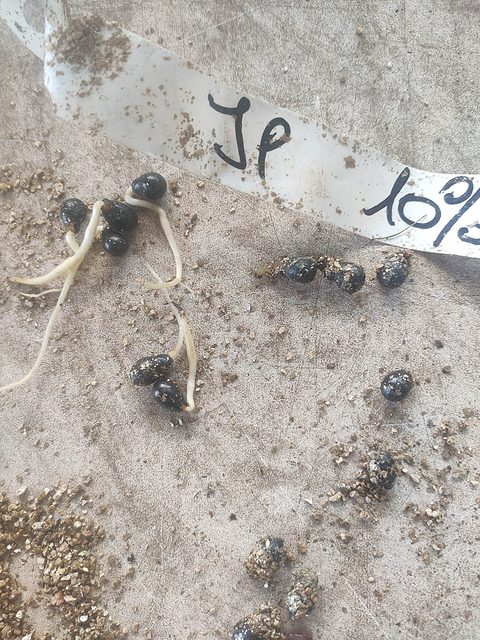







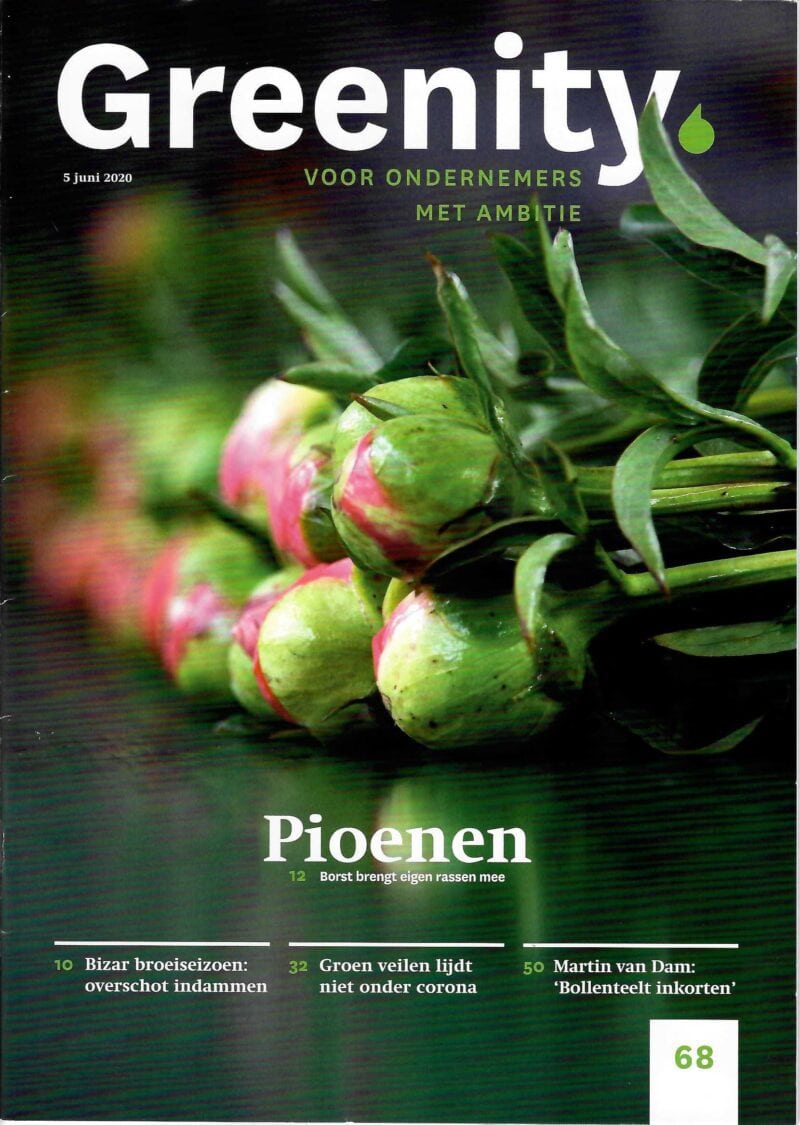

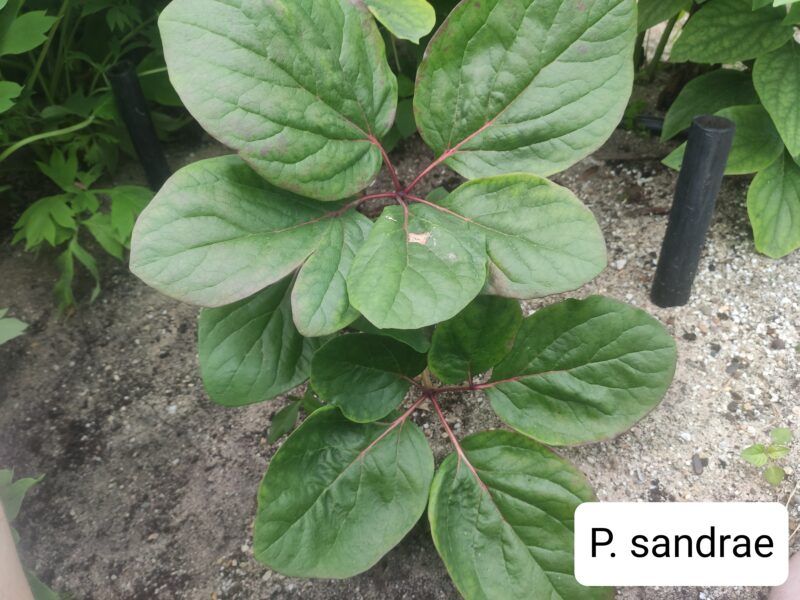
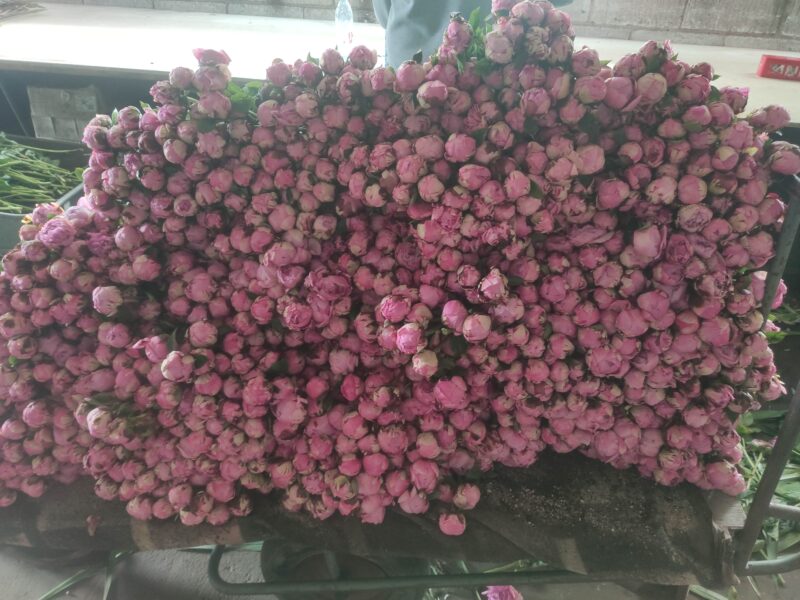
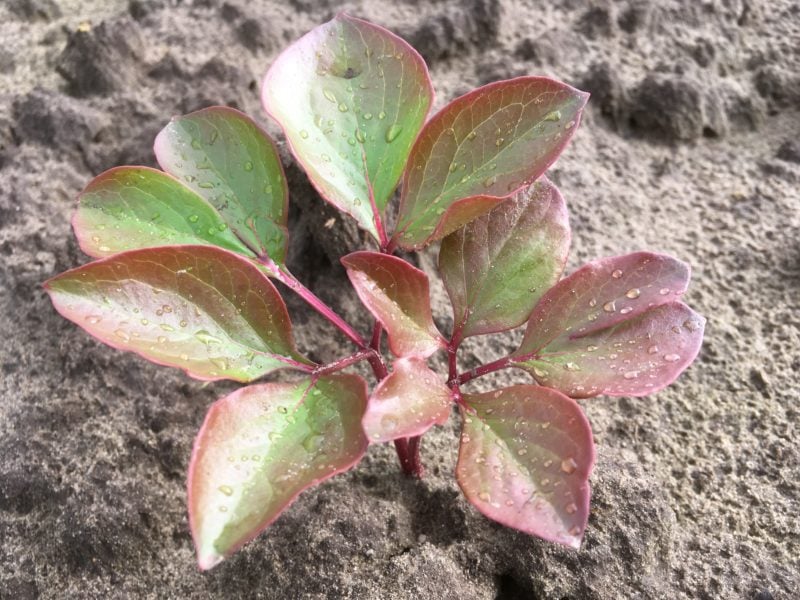
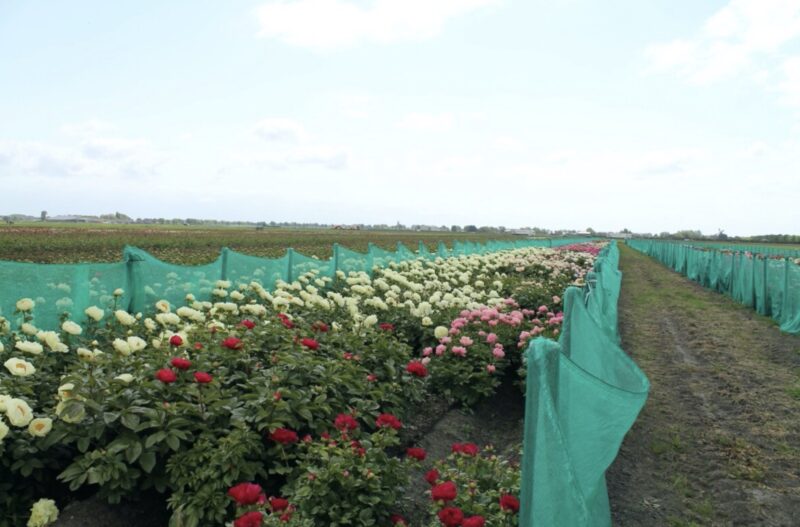

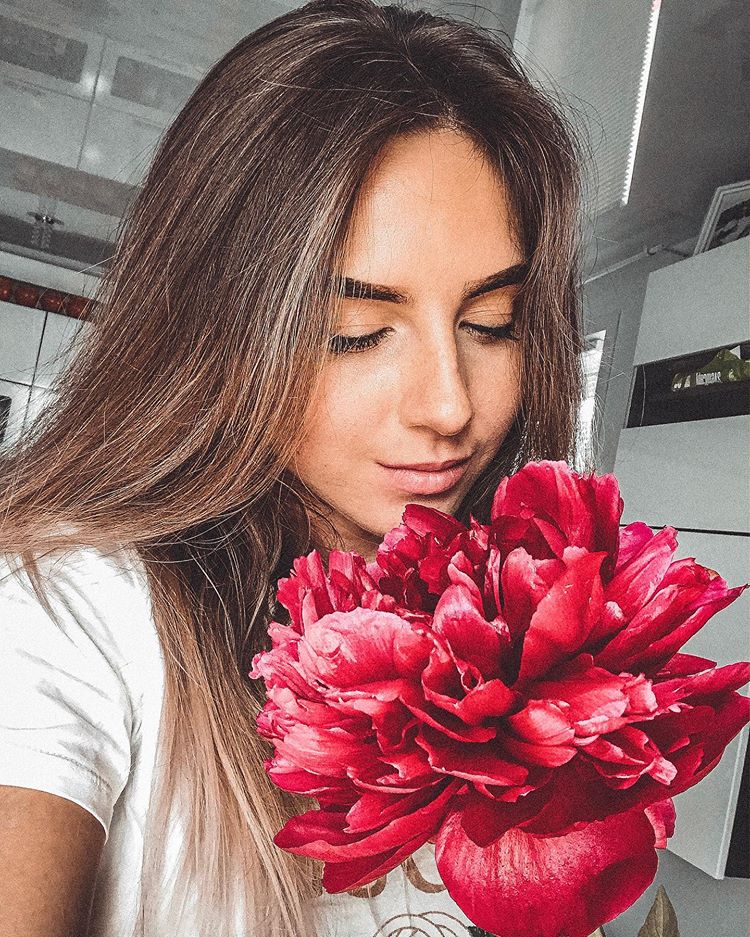

Interesting to see your results, and to see that you’ve gotten germination so quickly ! I’d be interested in knowing what your temperature routine was, and if you used this year’s seeds ?
I have my ways of doing it, but I can’t say that I’ve done as much experimenting as I should. I get results, so I’m happy, but since I’m getting something…I’m probably afraid to do too much experimenting out of fear I’ll get nothing.
And what about all those cracked seeds ? I get them with some crosses, but not others. ‘Laddie‘ seems to be the worst offender here – some years a large percentage of seeds will be ruptured, while other years most of them look fine. In the past I used to think that it had to do with widely varying amounts of soil moisture, which may still be the case. But different pollens seem to produce different results too.
My sense is that when we get brown tips on the end of the roots, it’s from too much moisture or a lack of air ?
I’ve come to where I now give all of my seeds, fresh or not, several days of soaking prior to putting them in the bags. And will give them a bleach solution rinse before I bag them too. My sense is that if I’ve soaked my seeds well before I bag them, then all that’s really needed in the bags is an atmosphere that can maintain 100% humidity. I use fairly coarse vermiculite rather than the very fine stuff, but that’s just a matter of preference, along with what happens to be in the big 4 cubic foot bag that I buy every few years.
One other thing about vermiculite – it does a good job of showing you which seeds are rotting, by the manner that it sticks to rotting seeds.
In any case, good for you for doing these sorts of experiments. I suspect others may be like myself – we do something that seems to provide us (for better or worse) with results, and then we tend to stop experimenting.
@bobjohnson Yes, this year’s seeds. But they were mature halfway August, earlier than yours. Then soaked for two days and then all the different treatments. The bags were placed in my unheated greenhouse. I should have logged the temperatures perhaps, but I didn’t (I’ll do that next year). The greenhouse vents are set to keep temperatures around 21-23°C (68°-74°F), although temperatures may have risen above this at times. There was no heating however, so temperatures during night will have gone down quite a bit as well. Last year I did the same treatment, but temperatures were not as high then and rooting occurred later, although here as well I don’t remember exactly when.
I am not sure about the exact treatment as well. I did receive some seeds later in the season and hesitated what to do with them. Place them in the greenhouse as well, although with decreasing temperatures they may not receive a long enough warm treatment. Or place them inside in a room where I can give additional heating? I’ve split them, but as it’s only a few seeds, I doubt much can be concluded from it if I would get some roots.
What I also wonder about: in the greenhouse they actually receive both warm and cold during the ‘warm period’. That’s more like will happen in nature of course. I have noticed that some of the seeds already had a plumule growing. So those must already have received their required cold period as well. Perhaps it’s thus possible to give both warm and cold period at the same time? Which is not necessarily very beneficial of course, I cannot plant them outside as they risk being frozen resulting in early death. And for some I do think outside planting after the first roots might be better, in pots there is always more risk of loss is my experience.
But what I reallly wanted to say: what would be best? Continuous warm temperature (as you would have inside) or alternating warm/cold temperatures, with probably the warm daily temperatures rather warm enough and for a long enough time? There sure is some more experimenting to do. But it will be for next year… I didn’t really mind all the failed germinations from Just Peachy. If not for this experiment I would never have collected the seeds at all.
I think the brown tips at the growing point of the roots are from too much moisture. If it were lack of air, I’d expect it to see at random throughout the experiment, which wasn’t the case, it deteriorated with increasing moisture levels.
The ruptured seeds I threw away weren’t necessarily bad, but I wanted to rule out the possibility that they would influence the results if they germinated less well or otherwise compared to ‘normal seeds’.